Characterization of the Thermoelectric Coolers and Fatty Acid as a Phase Change Material of the Portable Box Cooler
DOI:
https://doi.org/10.37934/arfmts.106.1.1622Keywords:
Cooler box, phase change material, thermoelectricAbstract
The utilization of portable box coolers (PBC) for traditional fishermen is quite popular in Indonesia. However, pure water's cooling medium is still limited to ice. With the development of PCM technology, the utilization of fatty acids began to be used. Likewise, the use of thermoelectric coolers (TEC) directly on PBCs has also been widely developed. In this study, a combination of utilization of PCM based on fatty acids, namely lauric acid, myristic acid, and stearic acid has been carried out with the addition of a TEC to PBC. The concentration of each use of fatty acids in pure water was 5 mg/L, and the use of pure water was also tested as a comparison. The PBC design was developed for this research and given a load of 5 watts lamps in each test. The study was carried out in two stages, firstly, the use of PCM without the use of TEC, and the second study was the combination of the use of PCM which was added with the use of a TEC. The results showed that using a fatty acid solution was able to maintain the air temperature in the PBC longer than using only pure water. The use of stearic acid solution produces the best performance which can be seen from the time it takes to maintain the air temperature in the PBC is the longest to reach the initial air temperature, which is 1,160 minutes, followed using myristic acid solution for 1,120 minutes, while the use of the lauric acid solution is only able to maintain air temperature in PBC for 1080 minutes. This can be caused by the melting point of stearic acid being higher than the use of myristic acid and lauric acid. However, these results show that they are better than pure water, which can only reach 900 minutes to maintain air temperature in PBC. Adding a TEC to PCM from fatty acids could extend the time to maintain the air temperature in the PBC by about 40 minutes. These results indicate that the use of these fatty acids as PCM media can work significantly in thermal energy storage.
Downloads
































